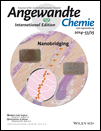Back Cover: Flow-Through Synthesis on Teflon-Patterned Paper To Produce Peptide Arrays for Cell-Based Assays (Angew. Chem. Int. Ed. 25/2014)
Graphical Abstract
Teflon-patterned paper that can be used for multistep organic synthesis and then used in cell-based assays has been developed. In their Communication on page 6374 ff., R. Derda and co-workers describe the deposition of Teflon onto paper to create solvent-resistant barriers. The reagents confined by the pattern flow through the layer(s) of paper, thus permitting parallel flow-through syntheses of 96 peptides on one sheet of paper to produce arrays that can be used for cell-based assays.





